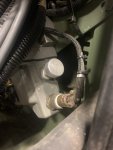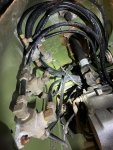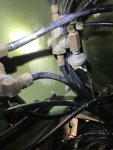Ronmar
Well-known member
- 4,459
- 8,370
- 113
- Location
- Port angeles wa
Well if the pressure is dropping, then you have a leak I think the controller pauses and looks for this pressure stability as a way to diagnose leaks. With control closed and a shot of air to pressurize the system it should be able to set there all day. For a given size hole, the greater the pressure, the greater the volume that passes thru it. It could be the control or dump valve is leaking out thru the floor vent behind the grill Or thru that pressure relief/regulator on the PCU. Or it is on the line out of the PCU. This line goes down by the passenger side of the transmission to a T fitting. Just forward of that T is the front axle dump valve. The other side of the T runs aft to the rear axle dump valve(s).
I think the controller pauses and looks for this pressure stability as a way to diagnose leaks. With control closed and a shot of air to pressurize the system it should be able to set there all day. For a given size hole, the greater the pressure, the greater the volume that passes thru it. It could be the control or dump valve is leaking out thru the floor vent behind the grill Or thru that pressure relief/regulator on the PCU. Or it is on the line out of the PCU. This line goes down by the passenger side of the transmission to a T fitting. Just forward of that T is the front axle dump valve. The other side of the T runs aft to the rear axle dump valve(s).
As soon as the pressure at the manifold side of the dump valve starts to drop below the tire pressure the dump valves being remote pressure regulators mimic this truck side pressure by passing tire air either back thru towards the PCU or venting it. The greater the pressure difference, the greater the dump. Now this leak could really be anywhere in the system. Since your tires hold air that means the diaphragm in the wheel valve is sealing the little center hole that feeds into the tire. But once the system pressure goes above 6-7 PSI that pressure lifts the diaphragm and that hole is exposed connecting the wheel to the system. A cracked diaphragm would now leak air into the valve casing and out to the atmosphere. As would the hose from valve to banjo, banjo bolt, hub seals and all the truck side plumbing.
A wheel valve leaking like this would leak tire air and also draw air from the truck side, fed by the rest of the tires, and if it pulls the truck side down far enough the dump valves will also vent air to match the truck side pressure…
Time to put in that test mode, break out the bubble mix and chase leaks…
As soon as the pressure at the manifold side of the dump valve starts to drop below the tire pressure the dump valves being remote pressure regulators mimic this truck side pressure by passing tire air either back thru towards the PCU or venting it. The greater the pressure difference, the greater the dump. Now this leak could really be anywhere in the system. Since your tires hold air that means the diaphragm in the wheel valve is sealing the little center hole that feeds into the tire. But once the system pressure goes above 6-7 PSI that pressure lifts the diaphragm and that hole is exposed connecting the wheel to the system. A cracked diaphragm would now leak air into the valve casing and out to the atmosphere. As would the hose from valve to banjo, banjo bolt, hub seals and all the truck side plumbing.
A wheel valve leaking like this would leak tire air and also draw air from the truck side, fed by the rest of the tires, and if it pulls the truck side down far enough the dump valves will also vent air to match the truck side pressure…
Time to put in that test mode, break out the bubble mix and chase leaks…





